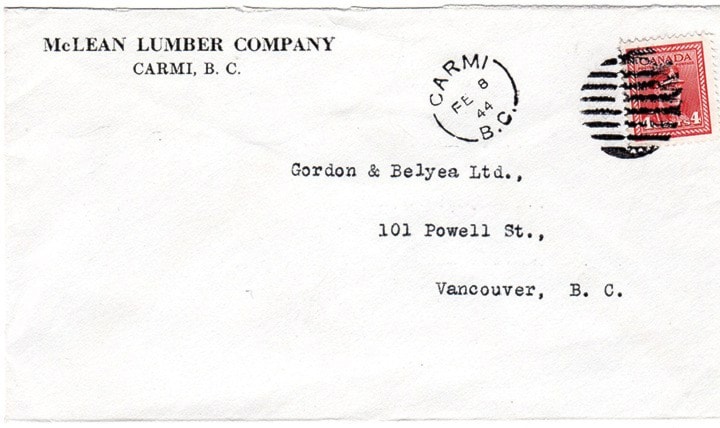Thirty-fourth in a sort of alphabetical series on West Kootenay/Boundary place names
According to the 1958 Boundary Historical Society, the ghost town of Carmi, on the west side of the Kettle River north of Beaverdell, was named after the Carmi mine, staked by James C. Dale (1848-?), who hailed from Carmi, Illinois. (That town was in turn was named for a Biblical figure.)
The claim was recorded on September 5, 1896 and mentioned in the Boundary Creek Times a week earlier. Carmi later took on airs as a townsite was laid out. The Greenwood Weekly Times of February 7, 1901 stated: “Jas. Dale, one of the owners of Carmi City, will arrived from the east in a few days.”
With partner James Kerr, Dale placed ads calling Carmi “The Payroll City of the West Fork” and “the Mining Center of the Upper West Fork Country.”
The Carmi post office opened on June 1, 1902 with Kerr as postmaster, followed in 1904 by Dale. It closed January 31, 1969.
The last vestige of old Carmi, the abandoned Smith House hotel, burned in 2000, although Carmi Station Road, which recalls the Kettle Valley Railway that passed through town, keeps the name alive.
Carmi, Illinois fared much better than Carmi, BC: it has a population today of over 5,200.
Cedar Point
This sternwheeler landing on the north shore of Kootenay Lake, near Willow Point, is noteworthy mainly because a post office operated there from January 1, 1912 to November 11, 1915 with H.A. Masters as postmaster.
It was on a 1924 map produced by the Department of the Interior and included in the 1930 BC Gazetteer, but it’s no longer in use.
Circle City

This obscure spot was first mentioned in the Revelstoke Herald of June 12, 1897: “Lou Thomson is putting up a hotel in Circle City on the Glacier ranch on the North Fork of the Lardeau.”
According to Milt Parent’s Circle of Silver, Thomson and partner Harry Carter hired A.P. Cummins to survey their 320-acre ranch as a townsite in 1900.
“This was a great sounding name given to their homestead,” Parent wrote. “They owned the Union Jack mine there and [newspaper publisher Parm] Pettipiece described the townsite as a good one.”
Ads in the Herald of 1902 promised Circle City as the terminus of a proposed railway, with “splendid water power” for concentrating plants.
However, it never amounted to much. It probably took its name from Circle City, Alaska, a gold rush town that today is known as just Circle, population 104.
Clark’s Camp
This spot seven miles up the North Fork of the Kettle River was the home of Robert Clark. The Grand Forks Gazette of March 27, 1897 reported that a petition was circulating to open a post office there with Clark as postmaster to serve miners and prospectors in the area. However, it never opened.
Previous installments in this series
Applegrove, Appleby, and Appledale revisited
Bakers, Birds, and Bosun Landing
Bannock City, Basin City, and Bear Lake City
Boswell, Bosworth, Boulder Mill, and Broadwater
Brooklyn, Brouse, and Burnt Flat
Camborne, Cariboo City, and Carrolls Landing
